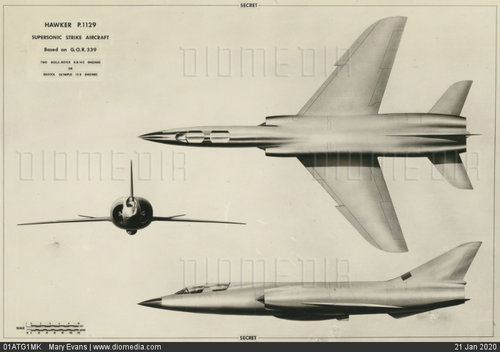- Joined
- 27 December 2005
- Messages
- 17,749
- Reaction score
- 26,422
alertken said:In the 1980s...a project was initiated into looking about bringing the TSR.2 back. Surely this is a canard (Ha!). Ex-BAC TSR.2 team members Freddie Page/B.O.Heath, now BAe. seniors, were preoccupied with deployment of Tornado and with the Saudi side of that programme, upon which BAe. was utterly dependent. Just what benefit, to anybody, could be inferred in resurrecting a 1958 notion, long superseded in avionics, structures, aerodynamic technologies? What could a Vulcan-sized nuclear strike/recce type do that Tornado (and applications from the EAP/ACA studies, to become Typhoon) could not?
norseman said:Anyone know what kind of thrust figures were being banded around at the time for the RR RB.142R engines which were pitched for a lot of these designs?
Also as a side note, anyone know how much of a study was done in the early 80's to resurrect the TSR.2? I know there was a general look at the viability but how much technical assesment was done, especially in the engine department as Olympus technology had moved on quite a bit by then (over 40,000lb dry which was in the pipeline for Concorde before ongoing development funds were cut, though geared for hi altitude efficiency) or was a move to turbofan looked at (originally an option anyway). ? Any info would be interesting as it is quite hard to find out any specifics other than a project was initiated into looking about bringing the TSR.2 back.
overscan said:While the GOR 339 submissions have been well illustrated by Tony Buttler, there are more details to be revealed.
pf matthews said:Today, during a "sort out", I came across an article from an old "Air Pictorial" which talks about the Governments (then CURRENT) investigation into reviving TSR.2.
If members are interested, I'll try to transcribe it for posting.
sealordlawrence said:PMN1 said:British Secret Projects: Bombers Since 1949, Tony Buttler
Page 112
A month later (November 1963) the Germans showed an interest in the aircraft as a replacement for the F104G; possibly 400 aircraft might be needed. Federal Minister of Defence Herr von Hassel and his party saw the prototype at Weybridge in May 1964 but there were concerns in the British Cabinet about repercussions in the UK if the Germans were allowed to buy an aircraft capable of delivering nuclear bombs, despite the fact they were still under United States custodial arrangements.
Anyone know what the Germans thought of the aircraft?
What they thought of it I do not know, but I do know that they would not have been buying 400 of them.
sealordlawrence said:rickshaw said:alertken said:In the 1980s...a project was initiated into looking about bringing the TSR.2 back. Surely this is a canard (Ha!). Ex-BAC TSR.2 team members Freddie Page/B.O.Heath, now BAe. seniors, were preoccupied with deployment of Tornado and with the Saudi side of that programme, upon which BAe. was utterly dependent. Just what benefit, to anybody, could be inferred in resurrecting a 1958 notion, long superseded in avionics, structures, aerodynamic technologies? What could a Vulcan-sized nuclear strike/recce type do that Tornado (and applications from the EAP/ACA studies, to become Typhoon) could not?
Fly further? Tornado has notoriously short legs, even compared to the Buccaneer.
And that makes up for all the other issues does it?
alertken said:rs: but it could. Central Front for Luftwaffe and RAFG, Baltic for Bundesmarine, S.Flank of Sovs'. central thrust, for Italian AF. Into Iran for Saudis. Your perceptions of "short legs" are post-demise of the design Threat.
norseman said:Anyone know what kind of thrust figures were being banded around at the time for the RR RB.142R engines which were pitched for a lot of these designs?
Also as a side note, anyone know how much of a study was done in the early 80's to resurrect the TSR.2? I know there was a general look at the viability but how much technical assesment was done, especially in the engine department as Olympus technology had moved on quite a bit by then (over 40,000lb dry which was in the pipeline for Concorde before ongoing development funds were cut, though geared for hi altitude efficiency) or was a move to turbofan looked at (originally an option anyway). ? Any info would be interesting as it is quite hard to find out any specifics other than a project was initiated into looking about bringing the TSR.2 back.
rickshaw said:Not really. I'm basing it upon comments about Buccaneers having to accompany Tonkas on their flights to the eastern Mediterranean and back in order to refuel them. Something the Buccs could do apparently with ease. Last time I checked, the eastern Med remains part of NATO even today. As I said, the Tonka has notoriously short legs.
Stargazer2006 said:Three-view drawing of Bristol Type 204 for GOR. 339 (source: Air Enthusiast, August 1971).
PaulMM (Overscan) said:Fairey P.75 GOR.339 at RAF Museum Cosford 2013. Photos by forum member Hobbes.
PaulMM (Overscan) said:Fairey P.75 GOR.339 at RAF Museum Cosford 2013. Photos by forum member Hobbes.

